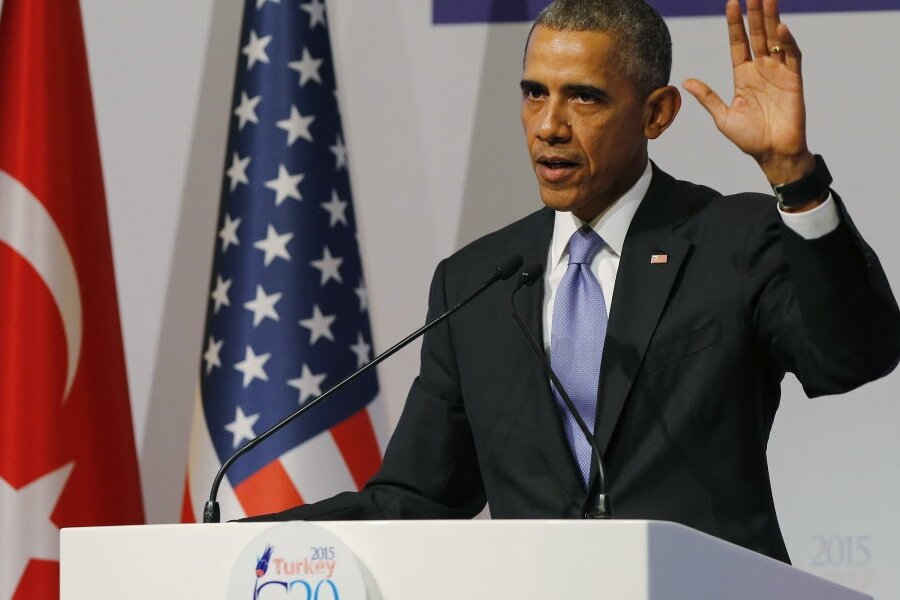Will Paris attacks prompt US boots on the ground in Syria?
Loading...
| Washington
The Paris attacks have triggered a fresh round of calls for sending American ground troops into Syria to root out a terrorist organization that has now demonstrated with deadly clarity that it intends to strike targets around the world, including in the West.
But while the debate over deploying large numbers of US troops is all but certain to intensify, the likelihood of a switch in US strategies any time soon to send in American soldiers to wage a ground war on the self-proclaimed Islamic State appears much less likely.
Perhaps most significantly, President Obama remains firmly opposed to the idea, as he stated again Monday at a press conference in Turkey. Sending a large number of troops to Syria would be a “mistake,” Mr. Obama said, because once again it would be the US trying to tackle a problem that ultimately can only be solved by local populations.
Saying he had “no doubt” that the “finest military in the world” could “march into Mosul or Raqqa or Ramadi and temporarily clear out ISIL,” Obama said it would leave the US with another Iraq-like occupation.
“We would see a repetition of what we’ve seen before,” he said, “which is, if you do not have local populations that are committed to inclusive governance and who are pushing back against ideological extremes … they resurface – unless we’re prepared to have a permanent occupation of these countries.”
But regional and military experts remain deeply divided over the idea of “boots on the ground” in Syria – and whether such a move would quickly dispense with a looming national security threat to the US and its allies, or result in yet another quagmire on the order of Afghanistan or Iraq.
“Such an invasion will deepen the extremist narrative of clash of civilizations between the West and Muslims, will insert our militaries in a deep, nasty, and unwinnable civil war, and the invading force will eventually be responsible for reconstructing a semblance of order and governance in a chaotic region infected with sectarian divisions,” says David Schanzer, associate professor in Duke University’s School of Public Policy and director of the Triangle Center on Terrorism and Homeland Security in Durham, N.C.
As “unsatisfying” as the US approach may be – a strategy that Obama defined last week as “containment” of the Islamic State (IS), also known as ISIS or ISIL – Dr. Schanzer says that “the basic contours of the current strategy are right.”
Not so, say others, who insist that only with boots on the ground can the US “destroy” IS, which is the president’s stated goal.
“The president says his goal is to ‘degrade and destroy’ ISIS, but you’re not going to do that with some additional air strikes,” says James Jeffrey, who was US ambassador to Iraq from 2010 to '12 and who has emerged as one of the most forceful advocates of sending in US ground troops to lead the fight against the Islamic State. “You might have a few successes tactically,” he adds, “but you aren’t going to defeat ISIS that way.”
Obama said his strategy is yielding results, as local fighters in Syria and Iraq take back terrain until recently held by IS. Secretary of State John Kerry, who made a surprise stop in Paris Monday evening to show American solidarity with France, said earlier that the US was “on the way” to defeating IS.
But whatever slow advances are being made against IS are not stopping the terrorist group from advancing its cause – and reach – in ways that the US cannot afford to allow to proceed, former Ambassador Jeffrey says.
“In the last month or so, we’ve seen four major attacks outside of the Syria-Iraq conflict area,” says Jeffrey, pointing to the Ankara bombings in October, the downing of a Russian airline over Egypt, the Beirut bombings, and Paris. “So the president has a strategy that hasn’t worked for 18 months, and it’s getting worse.”
Some military experts are promoting something of a middle ground, saying the US must, on the one hand, send in more special forces than the 50 Obama deployed to Syria last month to work alongside Kurdish and other opposition fighters – while keeping out ground forces that would feed the “Western invasion” narrative and potentially have a hard time getting back out.
“Yes, we need more special forces, mostly for training on location within Syria to get the opposition forces strong enough to change the battlefield dynamics. But not main combat formations,” says Michael O’Hanlon, national security and defense policy analyst at the Brookings Institution in Washington. “Hundreds or maybe a couple thousand troops,” he adds, “not tens of thousands.”
But advocates of sending in ground troops say a “quagmire” would not be inevitable.
“[Obama] is absolutely right to want to avoid an occupation, but that’s not what we’re talking about here,” says Jeffrey, now a visiting scholar at the Washington Institute for Near East Policy. “Once you defeat these guys as a state and a conventional army, then you pull back and focus on containing what’s left.”
And Jeffrey says there’s a model for how the US could then keep the IS remnants “contained,” and that’s Afghanistan.
“We have 10,000 troops there at reasonable cost and in relative security helping the Afghans against the Taliban, and we can keep the 10,000 in there basically forever,” he says.
Even before Obama gave his press conference Monday, White House advisers were busy assuring reporters that any talk of “stepped up” US action in the wake of the Paris bombings would not extend to deployment of US ground troops.
That may remain true in the short term, Jeffrey says, but he adds that his diplomatic experience taught him something: “Presidents can change.”
To that he adds that, without a dramatic shift in strategy, “[Obama] is going to be handing this problem off to his successor.”








